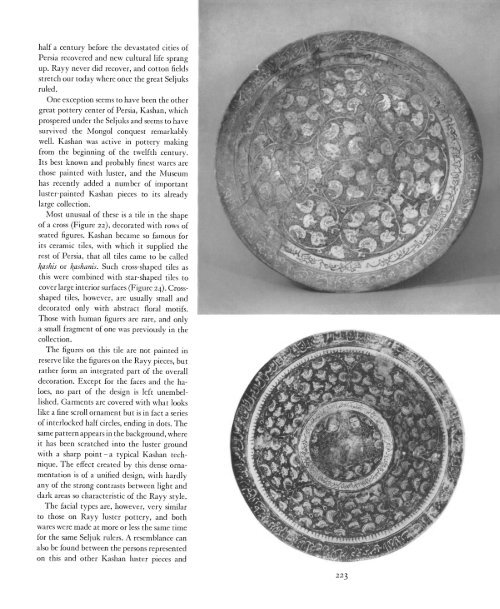Islamic Art: The Metropolitan Museum of Art Bulletin, v. 23, no. 6 ...
Islamic Art: The Metropolitan Museum of Art Bulletin, v. 23, no. 6 ...
Islamic Art: The Metropolitan Museum of Art Bulletin, v. 23, no. 6 ...
Create successful ePaper yourself
Turn your PDF publications into a flip-book with our unique Google optimized e-Paper software.
half a century before the devastated cities <strong>of</strong><br />
Persia recovered and new cultural life sprang<br />
up. Rayy never did recover, and cotton fields<br />
stretch our today where once the great Seljuks<br />
ruled.<br />
One exception seems to have been the other<br />
great pottery center <strong>of</strong> Persia, Kashan, which<br />
prospered under the Seljuks and seems to have<br />
survived the Mongol conquest remarkably<br />
well. Kashan was active in pottery making<br />
from the beginning <strong>of</strong> the twelfth century.<br />
Its best k<strong>no</strong>wn and probably finest wares are<br />
those painted with luster, and the <strong>Museum</strong><br />
has recently added a number <strong>of</strong> important<br />
luster-painted Kashan pieces to its already<br />
large collection.<br />
Most unusual <strong>of</strong> these is a tile in the shape<br />
<strong>of</strong> a cross (Figure 22), decorated with rows <strong>of</strong><br />
seated figures. Kashan became so famous for<br />
its ceramic tiles, with which it supplied the<br />
rest <strong>of</strong> Persia, that all tiles came to be called<br />
kashis or kashanis. Such cross-shaped tiles as<br />
this were combined with star-shaped tiles to<br />
cover large interior surfaces (Figure 24). Crossshaped<br />
tiles, however, are usually small and<br />
decorated only with abstract floral motifs.<br />
Those with human figures are rare, and only<br />
a small fragment <strong>of</strong> one was previously in the<br />
collection.<br />
<strong>The</strong> figures on this tile are <strong>no</strong>t painted in<br />
reserve like the figures on the Rayy pieces, but<br />
rather form an integrated part <strong>of</strong> the overall<br />
decoration. Except for the faces and the haloes,<br />
<strong>no</strong> part <strong>of</strong> the design is left unembellished.<br />
Garments are covered with what looks<br />
like a fine scroll ornament but is in fact a series<br />
<strong>of</strong> interlocked half circles, ending in dots. <strong>The</strong><br />
same pattern appears in the background, where<br />
it has been scratched into the luster ground<br />
with a sharp point-a typical Kashan technique.<br />
<strong>The</strong> effect created by this dense ornamentation<br />
is <strong>of</strong> a unified design, with hardly<br />
any <strong>of</strong> the strong contrasts between light and<br />
dark areas so characteristic <strong>of</strong> the Rayy style.<br />
<strong>The</strong> facial types are, however, very similar<br />
to those on Rayy luster pottery, and both<br />
wares were made at more or less the same time<br />
for the same Seljuk rulers. A resemblance can<br />
also be found between the persons represented<br />
on this and other Kashan luster pieces and<br />
2<strong>23</strong>

















